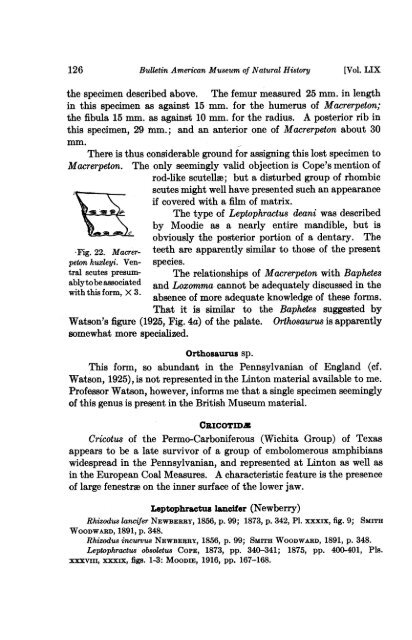View/Open - American Museum of Natural History
View/Open - American Museum of Natural History
View/Open - American Museum of Natural History
You also want an ePaper? Increase the reach of your titles
YUMPU automatically turns print PDFs into web optimized ePapers that Google loves.
126 Bulletin <strong>American</strong> <strong>Museum</strong> <strong>of</strong> <strong>Natural</strong> <strong>History</strong><br />
[Vol. LIX<br />
the specimen described above. The femur measured 25 mm. in length<br />
in this specimen as against 15 mm. for the humerus <strong>of</strong> Macrerpeton;<br />
the fibula 15 mm. as against 10 mm. for the radius. A posterior rib in<br />
this specimen, 29 mm.; and an anterior one <strong>of</strong> Macrerpeton about 30<br />
mm.<br />
There is thus considerable ground for assigning this lost specimen to<br />
Macrerpeton. The only seemingly valid objection is Cope's mention <strong>of</strong><br />
rod-like scutellae; but a disturbed group <strong>of</strong> rhombic<br />
scutes might well have presented such an appearance<br />
if covered with a film <strong>of</strong> matrix.<br />
The type <strong>of</strong> Leptophractus deani was described<br />
by Moodie as a nearly entire mandible, but is<br />
obviously the posterior portion <strong>of</strong> a dentary. The<br />
Fig. 22. Macrer- teeth are apparently similar to those <strong>of</strong> the present<br />
peton huxleyi. Ven- species.<br />
tral scutes presum- The relationships <strong>of</strong> Macrerpeton with Baphetes<br />
ablytobeasociated<br />
and Loxomma cannot be adequately discussed in the<br />
absence <strong>of</strong> more adequate knowledge <strong>of</strong> these forms.<br />
with this form, X 3.<br />
That it is similar to the Baphetes suggested by<br />
Watson's figure (1925, Fig. 4a) <strong>of</strong> the palate. Orthosaurus is apparently<br />
somewhat more specialized.<br />
Orthosaurus sp.<br />
This form, so abundant in the Pennsylvanian <strong>of</strong> England (cf.<br />
Watson, 1925), is not represented in the Linton material available to me.<br />
Pr<strong>of</strong>essor Watson, however, informs me that a single specimen seemingly<br />
<strong>of</strong> this genus is present in the British <strong>Museum</strong> material.<br />
CRICOTIDS<br />
Cricotus <strong>of</strong> the Permo-Carboniferous (Wichita Group) <strong>of</strong> Texas<br />
appears to be a late survivor <strong>of</strong> a group <strong>of</strong> embolomerous amphibians<br />
widespread in the Pennsylvanian, and represented at Linton as well as<br />
in the European Coal Measures. A characteristic feature is the presence<br />
<strong>of</strong> large fenestrae on the inner surface <strong>of</strong> the lower jaw.<br />
Leptophractus lancifer (Newberry)<br />
Rhizodus lancifer NEWBERRY, 1856, p. 99; 1873, p. 342, P1. xxxix, fig. 9; SMITH<br />
WOODWARD, 1891, p. 348.<br />
Rhizodus incurvus NEWBERRY, 1856, p. 99; SMITH WOODWARD, 1891, p. 348.<br />
Leptophractus obsoletus COPE, 1873, pp. 340-341; 1875, pp. 400-401, Pls.<br />
viii, xxxix, figs. 1-3: MOODIE, 1916, pp. 167-168.
















